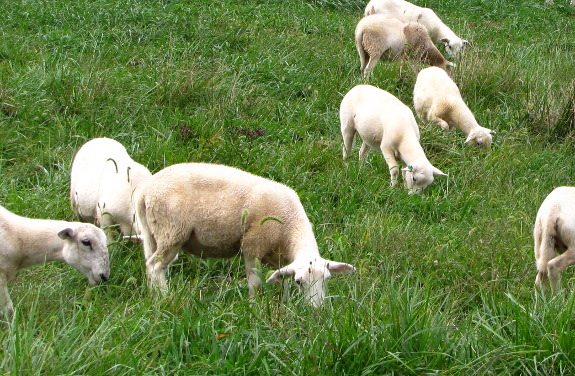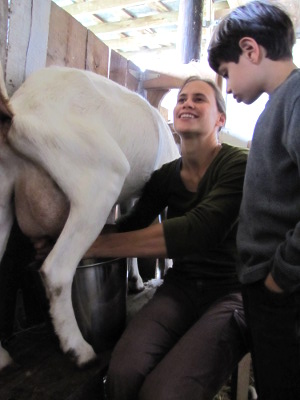
Mitigating factors in meat efficiency
 The
efficiency figures in my last post for raising various types of
meat make some big assumptions that aren't even true in cultures like
ours where most livestock are raised in factory farms, and are even
less true in other parts of the world. For example, the
astonishingly inefficient beef figures are mitigated by the fact that
most cattle, even in the U.S., are raised on pasture with little or no
grain during their youth, and are only moved to feedlots to be fattened
before slaughter. Next, consider that the hides of cows are used
for leather, collagen from connective tissue is used to make glue,
gelatin is eaten and used in plastic, and fats are used in soaps and
other applications. Factoring in these two new bits of data,
Fairlie further crunches the numbers to lower the feed conversion ratio
of beef in industrial societies to around 7:1 or 8:1.
The
efficiency figures in my last post for raising various types of
meat make some big assumptions that aren't even true in cultures like
ours where most livestock are raised in factory farms, and are even
less true in other parts of the world. For example, the
astonishingly inefficient beef figures are mitigated by the fact that
most cattle, even in the U.S., are raised on pasture with little or no
grain during their youth, and are only moved to feedlots to be fattened
before slaughter. Next, consider that the hides of cows are used
for leather, collagen from connective tissue is used to make glue,
gelatin is eaten and used in plastic, and fats are used in soaps and
other applications. Factoring in these two new bits of data,
Fairlie further crunches the numbers to lower the feed conversion ratio
of beef in industrial societies to around 7:1 or 8:1.
Pigs and chickens
produce fewer useful side products and don't get as much out of grass,
so their feed conversion ratios stand firm if you stick to industrial
conditions. However, if we went back in time even twenty years,
before it became illegal to feed wasted human food to livestock, pigs
especially would become much more efficient converters of grain to
meat. Fairlie suggests that if we simply used the food thrown
away by Americans every day, swill would supply 9% of the diet of the
pigs in our current factory farms, and that doesn't factor in other
historical feeds such as whey, spoiled produce on farms, and
slaughterhouse wastes. In poorer countries that haven't
implemented anti-swill-feeding  laws, pigs are often fed only
1.76 pounds of grain for every pound of meat produced, which would be
an astonishing feed conversion rate of 1.1:1 calorically, if my math is
right. (I'm guessing 1385 calories per
pound of pork and 898 calories per pound of grain.)
laws, pigs are often fed only
1.76 pounds of grain for every pound of meat produced, which would be
an astonishing feed conversion rate of 1.1:1 calorically, if my math is
right. (I'm guessing 1385 calories per
pound of pork and 898 calories per pound of grain.)
While swill is most
important when making chickens and pigs more efficient, ruminants like
cows and sheep pull their weight in areas with lots of non-arable
ground. For example, most of our farm couldn't be plowed without
producing extreme erosion, but if I were willing to cut down trees, we
could rotationally graze ruminants on our entire acreage and get food
from "unusable" land. In the UK, dairy cattle were historically
raised in spots like this, getting half their protein from grass and
half from grain, with a protein conversion rate for the milk of
1.5:1. Considering that animal protein is thought to be 1.4 times
as nutritionally beneficial as plant protein, that sounds like a very
efficient use of grain!
| This post is part of our Meat lunchtime series.
Read all of the entries: |
Want more in-depth information? Browse through our books.
Or explore more posts by date or by subject.
About us: Anna Hess and Mark Hamilton spent over a decade living self-sufficiently in the mountains of Virginia before moving north to start over from scratch in the foothills of Ohio. They've experimented with permaculture, no-till gardening, trailersteading, home-based microbusinesses and much more, writing about their adventures in both blogs and books.
Want to be notified when new comments are posted on this page? Click on the RSS button after you add a comment to subscribe to the comment feed, or simply check the box beside "email replies to me" while writing your comment.

When I lived in Olympia, I bought a lamb (for eating) every year from a farm on the next bay. That farm raised a small group of sheep every year, on acerage too wet and steep for year round livestock. They would get in young sheep every springtime, once the ground dried enough, and slaughter them every fall before the winter rains started, and sell them to the townsfolk. That way they were able to preserve their hilly woodlands from erosion during the wet season, and help generate cash for their coffers. My understanding is that there is much land that is not suitable for agriculture but suitable for livestock of various sorts, depending on how it is managed...
I have learned a lot from reading the blog "Throwback At Trapper Creek"* written by a woman who raises beef cattle in the PNW, and who uses a very thoughful method of rotational grazing that is gradually restoring her land to a high level of fertility, while also feeding her livestock.
*http://matronofhusbandry.wordpress.com/
ruminants like cows and sheep pull their weight in areas with lots of non-arable ground.
That's always been why I've never held with the "animal protein is a much less efficient use of land than plant protein!" argument. Animals can be raised on land that can't be productively used to grow crops, thus completely negating the "either/or" dichotomy. The most sustainable form of agriculture is mixed agriculture; industrial plant farming is as unsustainable as industrial animal farming (and as ethically dubious).
I really enjoy your book post series. Thanks for reading this stuff so I don't have to [yet].
My husband and I were discussing yesterday's post about beef, etc and came to the same conclusion - that not all factors were being taken into consideration. I'm glad to know that we were right.
We also have to expand that "eficiency audit" a little: considering our digestive inefficiencies, it makes more sense to let plants like grass capture the Sun's energy and the ruminants to capture that energy and put it into meat, whch we digest more efficiently than we digest plants.
Secondly, paasture is a more natural use of land than rasising crops, with skads less fossil fuel & chemicals needed to raise animals than plant, not to mention the producer's time.
Third, the calorie/protein ratio of a veg diet is unhealthy: it takes 3200 cal of rice, beans & corn to provide 60gm prot/d, but only 500 cal of beef. The beef also contains many times more of most vit & minerals than plants. (Plants should really only be considered as CHO calorie sources for us.)
And when we consider eliminating the grain feeds from the animals' diet, feed efficiency becomes an useless argument. Grain feeding merely puts more weight on each head, increasing the producer's profit per head, but not significantly changing things for the consummer. One grass-fed cow will give you 1/2 lb of beef to eat every day for 2.5 yrs. Grain fed will give you meat for 2.75 yrs. If you're not selling the meat, you lose money by grain feeding.